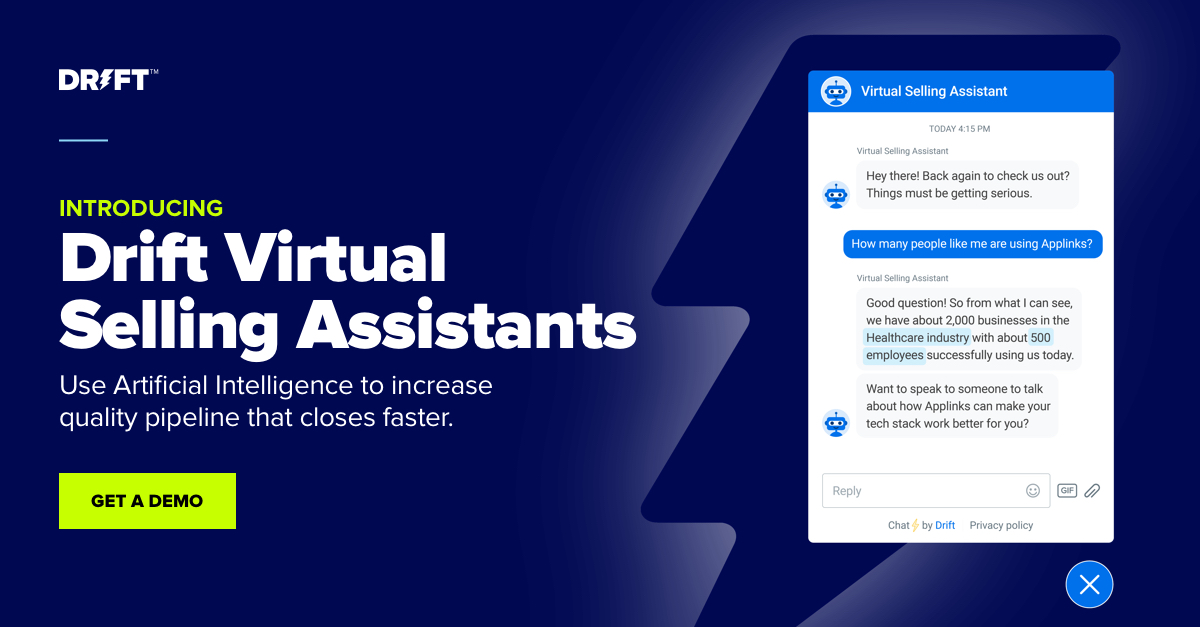Every single component of your go-to-market strategy probably changed last year.
Every. Single. One.
Buyers, sellers, personas, ideal customer profile, messaging, value prop…the list goes on and on.
Overwhelming, right?
That’s why I spoke with Chad Nuss, Founder and Chief Revenue of InsideOut, to break down how to tackle a full-blown sales transformation so you can be ready for anything 2021 throws at you.
If you want to watch our presentation, click here. Otherwise, keep reading for all the insights 💡
9 Steps to Improve Sales Performance Today
Fundamentally, sales teams can transform in two ways: internally and externally.
- Internally means re-organizing your teams, building a rigorous process to design new plays, and using technology to make them happen.
- Externally means experimenting with plays, choosing the ones that win, and making it possible for everyone on your team to repeat and scale them.
Let’s be real: It’s much, much easier to write about transformation than it is to actually do it. So we’ve broken it out into nine steps – even one of these will help improve sales performance and boost your ROI today.
1. Define Your Sales Play
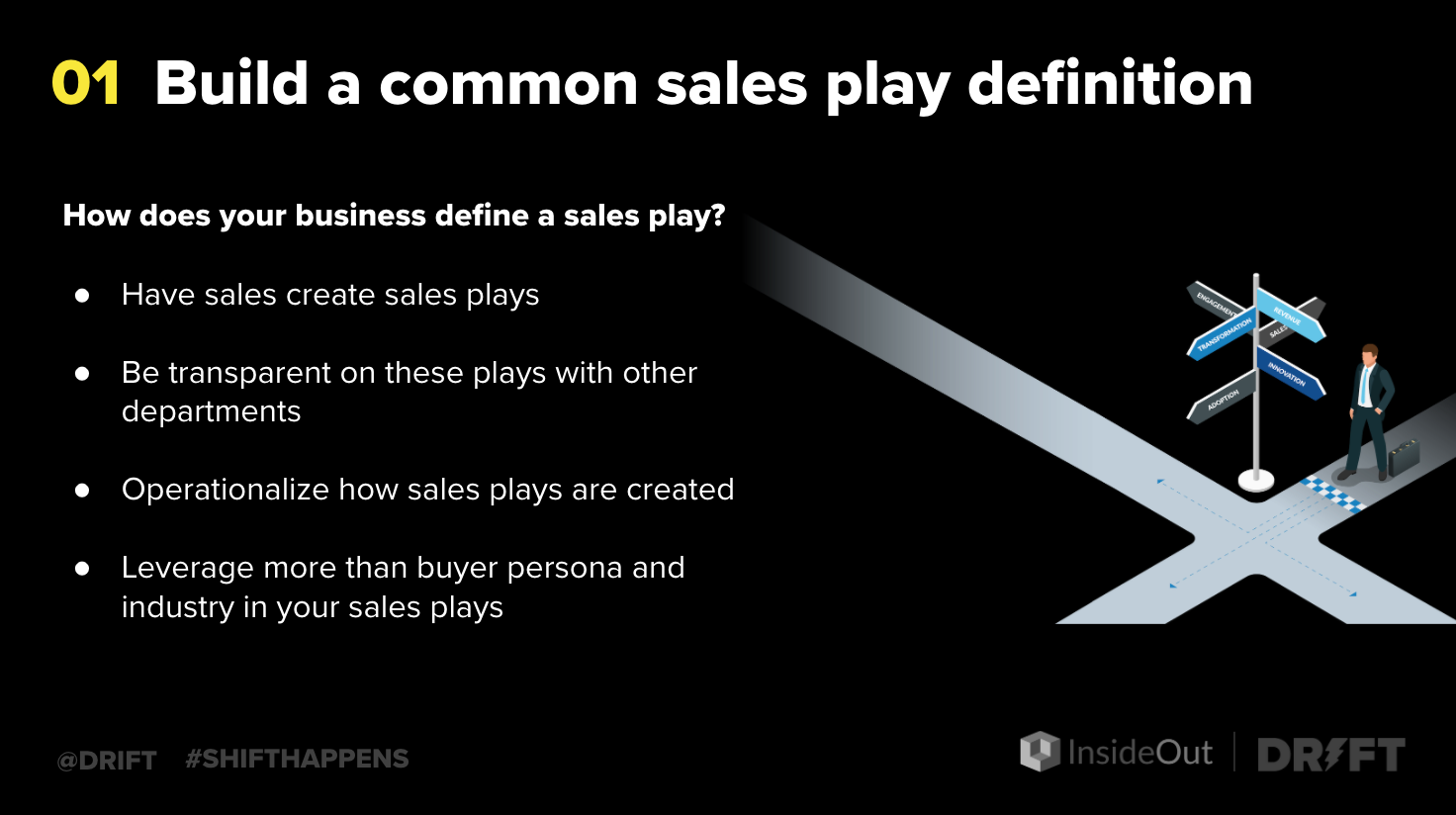
Ask a few different people on your team, “What’s a sales play?”
Chances are, you’ll get different definitions.
It’s time to organize around a common definition against different play attributes: buyer persona, industry, offer, inbound and outbound, sales motion, net new, renew, cross-sell.
All of these deserve different words, different conversations, and different engagement strategies.
That way, when someone says, “I’ve got a sales play,” you can say, “Got it. That’s for buyer persona one, industry four.”
Doing this unlocks personalization at scale. You don’t have to handcraft every single message to every single person you’re reaching out to, but every play should change based on the play attributes.
Want to engage your buyers 24/7/365, across the globe? Learn more about Drift conversational ai (and how they can help you hit your number) here.
2. Design sales plays collaboratively
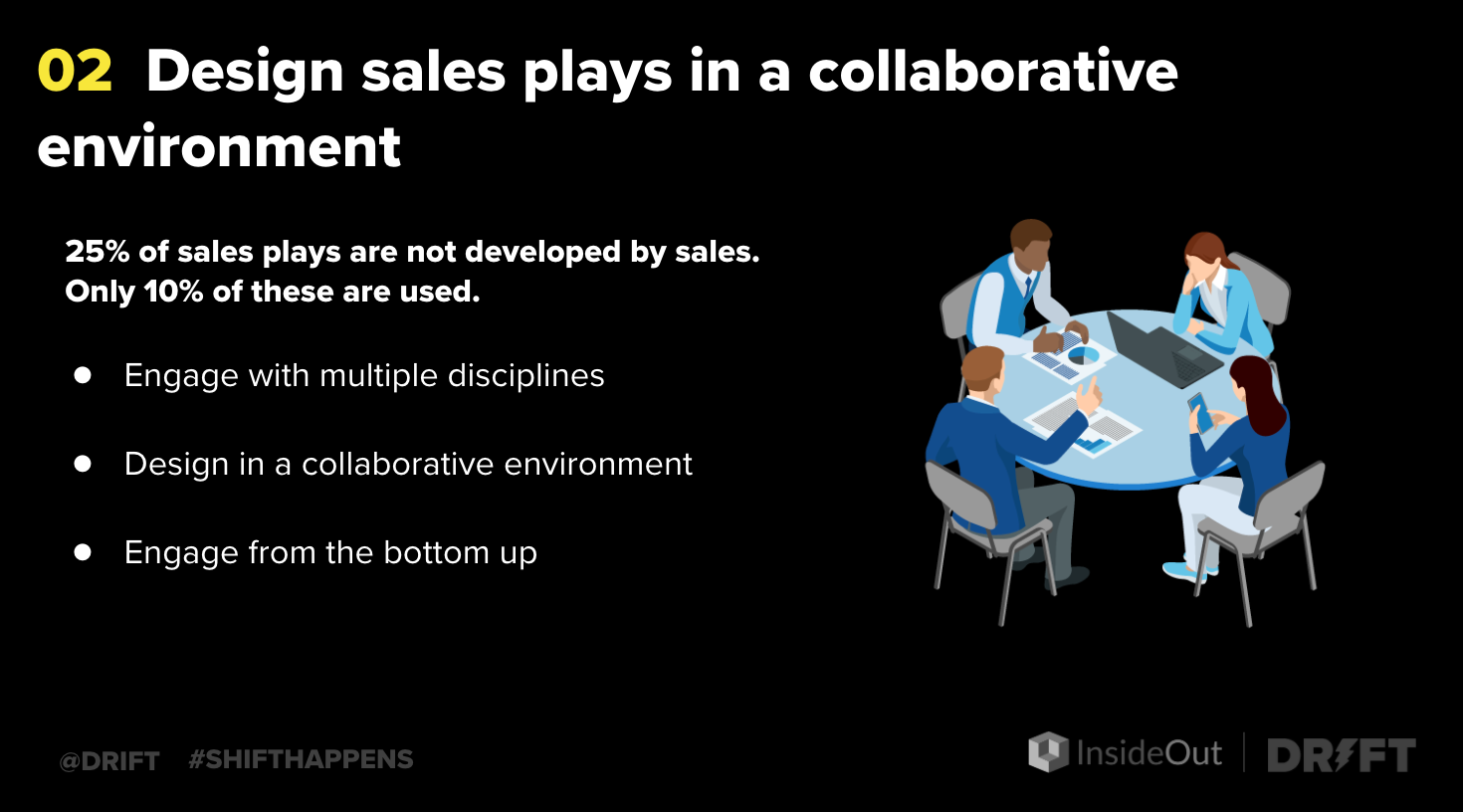
Successful plays need to come from everyone on your team, not just sales. Success, support, marketing, enablement, and training need to collaborate from the bottom-up to build plays that work.
When we came together to revamp our plays a few months ago, we found that one of our teams used a specific play. My team used a completely different sequence for the exact same scenario, but their team improved sales performance with a 22% reply rate. (Compared to our 11%!)
Obviously, we shifted to run their play instead. And guess what? It worked for us, too.
By collaborating, we learn from each other – and everybody wins.
3. Run a production cycle like an engineer
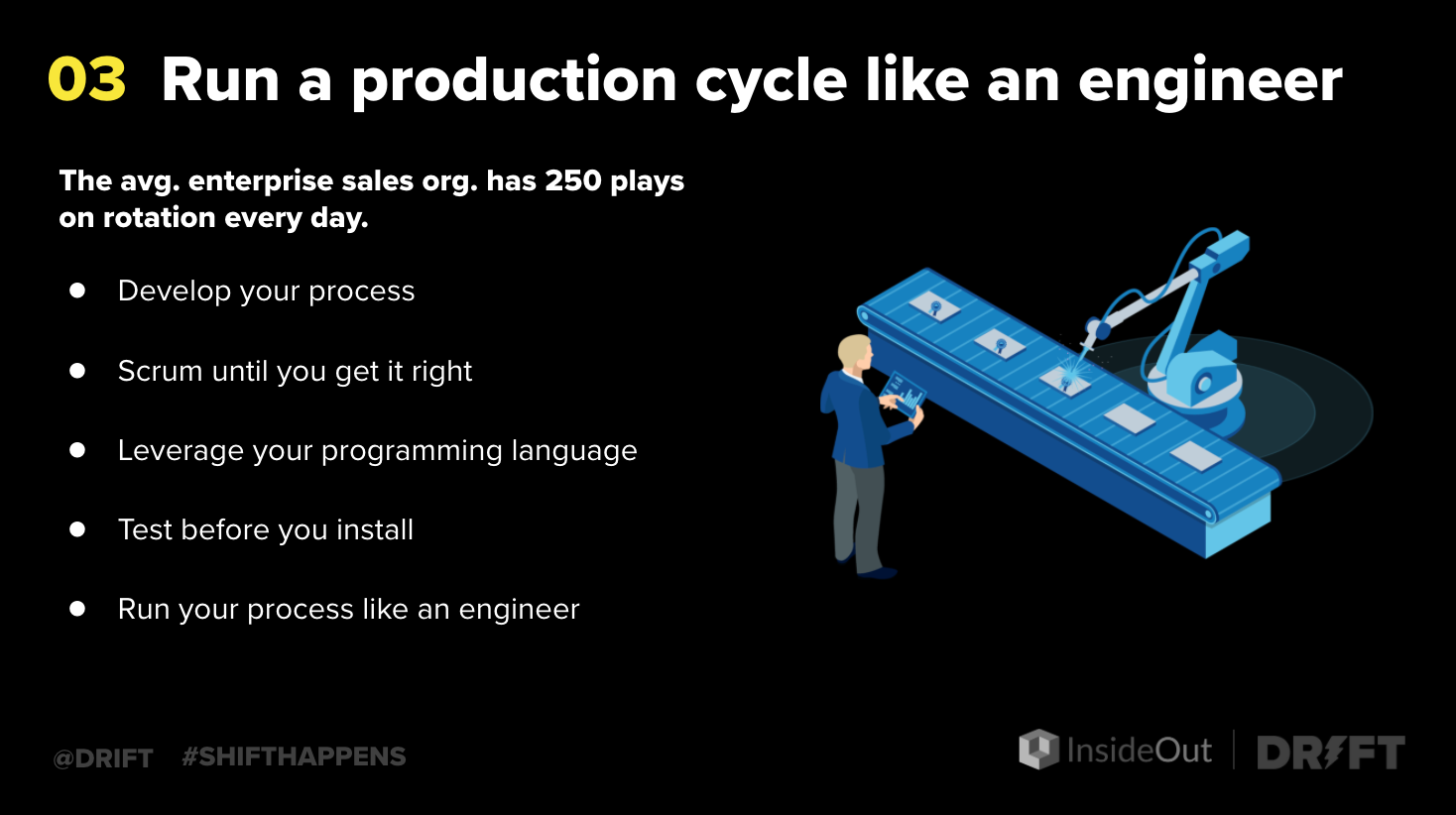
Like the Goonies, sales plays never say die.
They change, adding features and functionality, just like the way your engineering team builds your products. They never stop adding new things, so why should you?
Improve sales performance by developing a monthly rhythm of business that allows you to design, build, test, install, monitor…and then do it all again, for every play.
People talk about the science and art of sales. But are they truly thinking about plays methodically?
The rest of your teams run on a systematic, methodical process to execute new campaigns and products. Why not you?
4. Install your sales plays like a pro
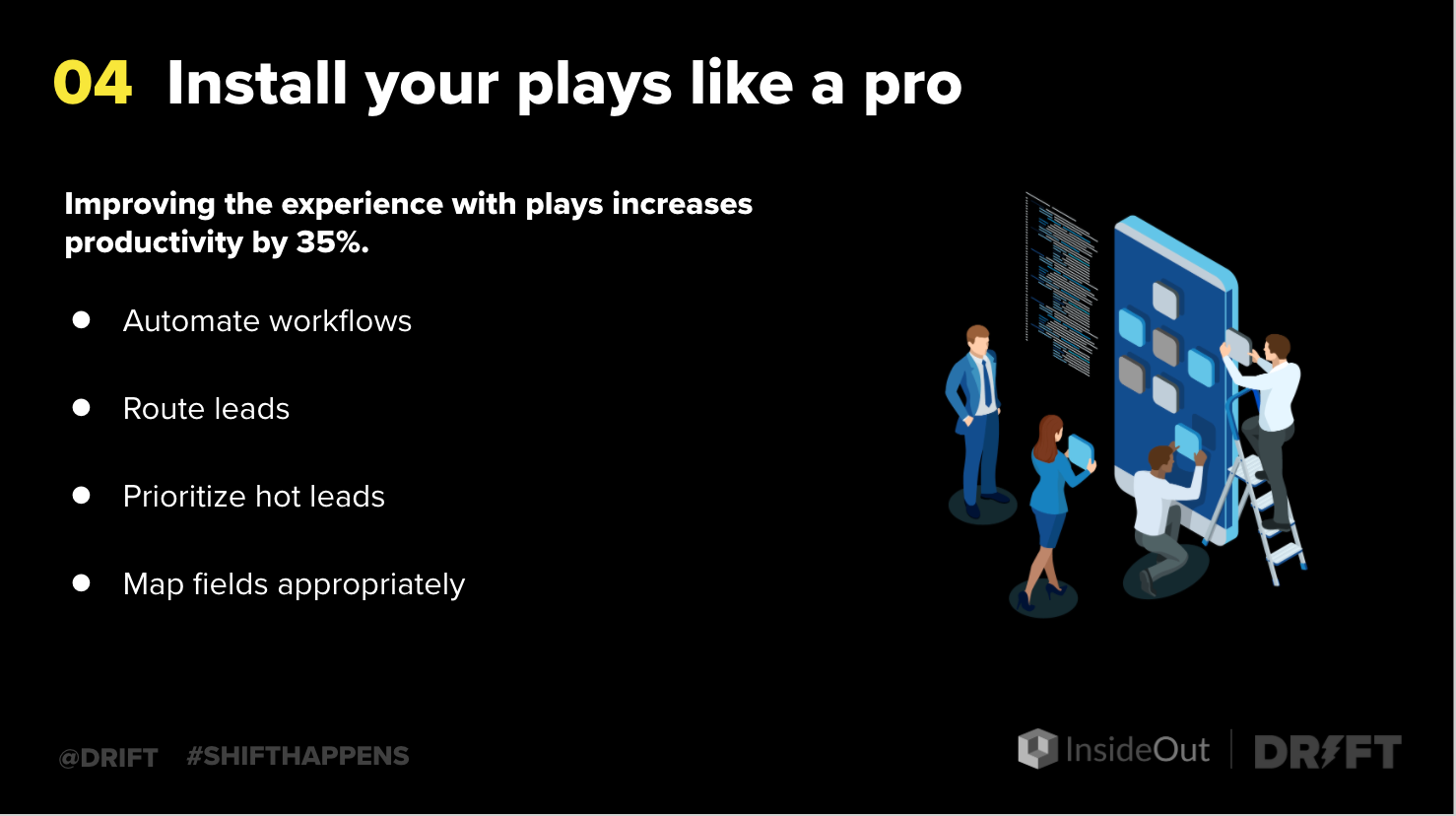
The way to enable that systematic process? Your tech stack.
InsideOut found that most companies use only 40-60% of the features and functionality available to them in the products they’ve already purchased.
What?
Look, we’re all busy. It’s easy to miss new features. But if you’re not using your technology to power your teams, you’re missing out on the value of your investment.
At Drift, our goal is to help businesses humanize their sales interactions, and we also provide AI chatbot software to automate and improve sales performance. How do they go together? The more you can automate, the more your team can spend time personalizing speaking with their prospects, go deep to understand the challenges that they’re experiencing, and figure out how to solve them.
(If you’re a Drift customer (hi 👋) we’ve got some product updates for you – check them out here.)
5. Encourage specializations
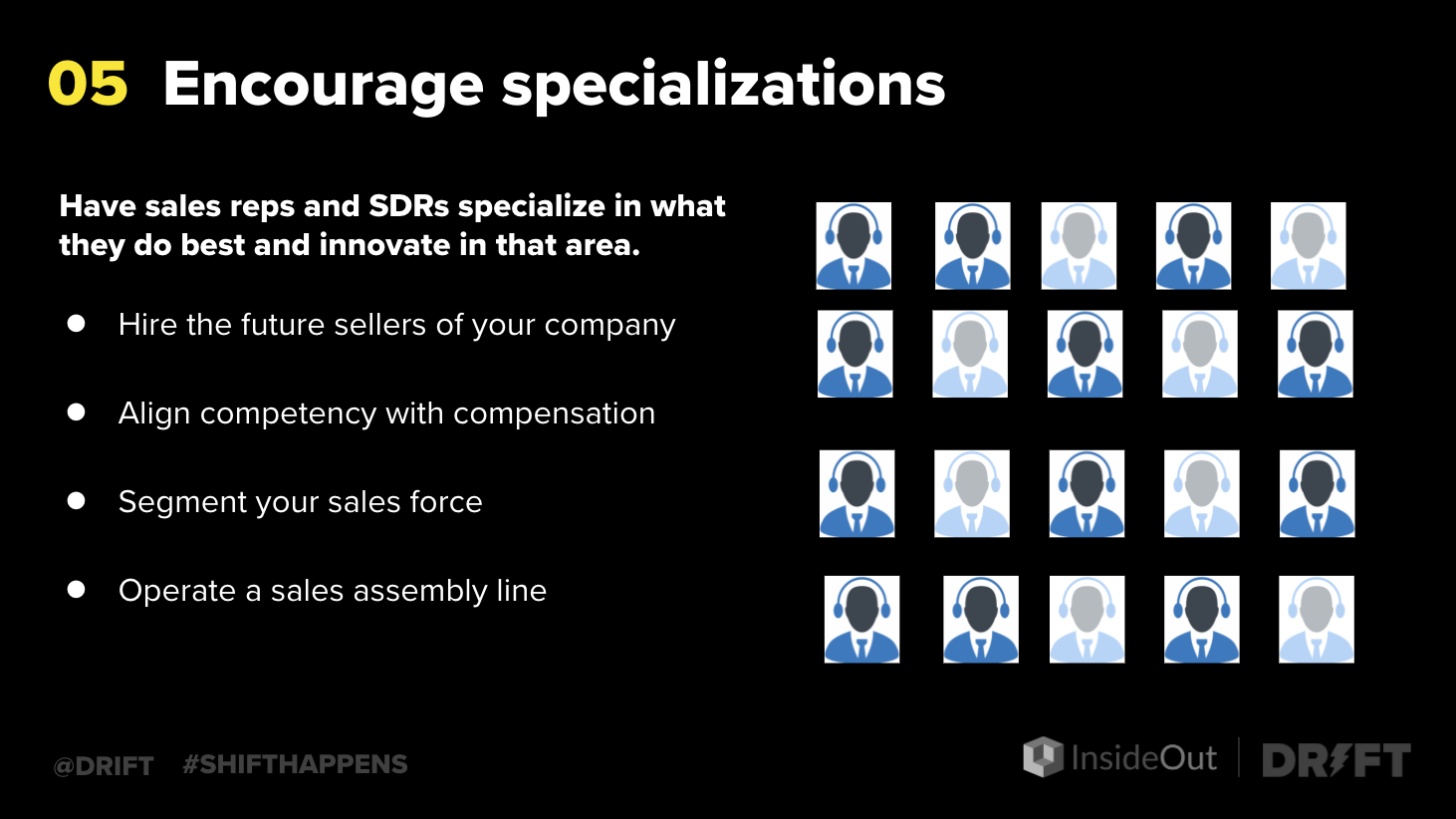
Any sales team has a finite capacity. They’ve only got so many hours and a specific number to hit.
The platforms we use dictate this capacity.
When you think about specialization, it’s about driving more sales productivity. It gives you a way to take the capacity of a team and redefine it.
Segment your sellers into the skills they’re best at.
Your AEs’ strongest skill set is diving into customer problems at the deepest level, engaging prospects throughout the sales cycle, moving the deal forward. So let’s get them focusing on the parts of the sales cycle they are best at and leave the prospecting to SDRs.
By specializing, you improve sales performance by letting people work on what they’re really good at.
You can also segment your team industry. If you target several verticals, instead of training and enabling 20 sellers on financial services, pick two people – especially two with a background in that industry – and use them to test out what works and what doesn’t.
6. Build experimentation into the sales cycle
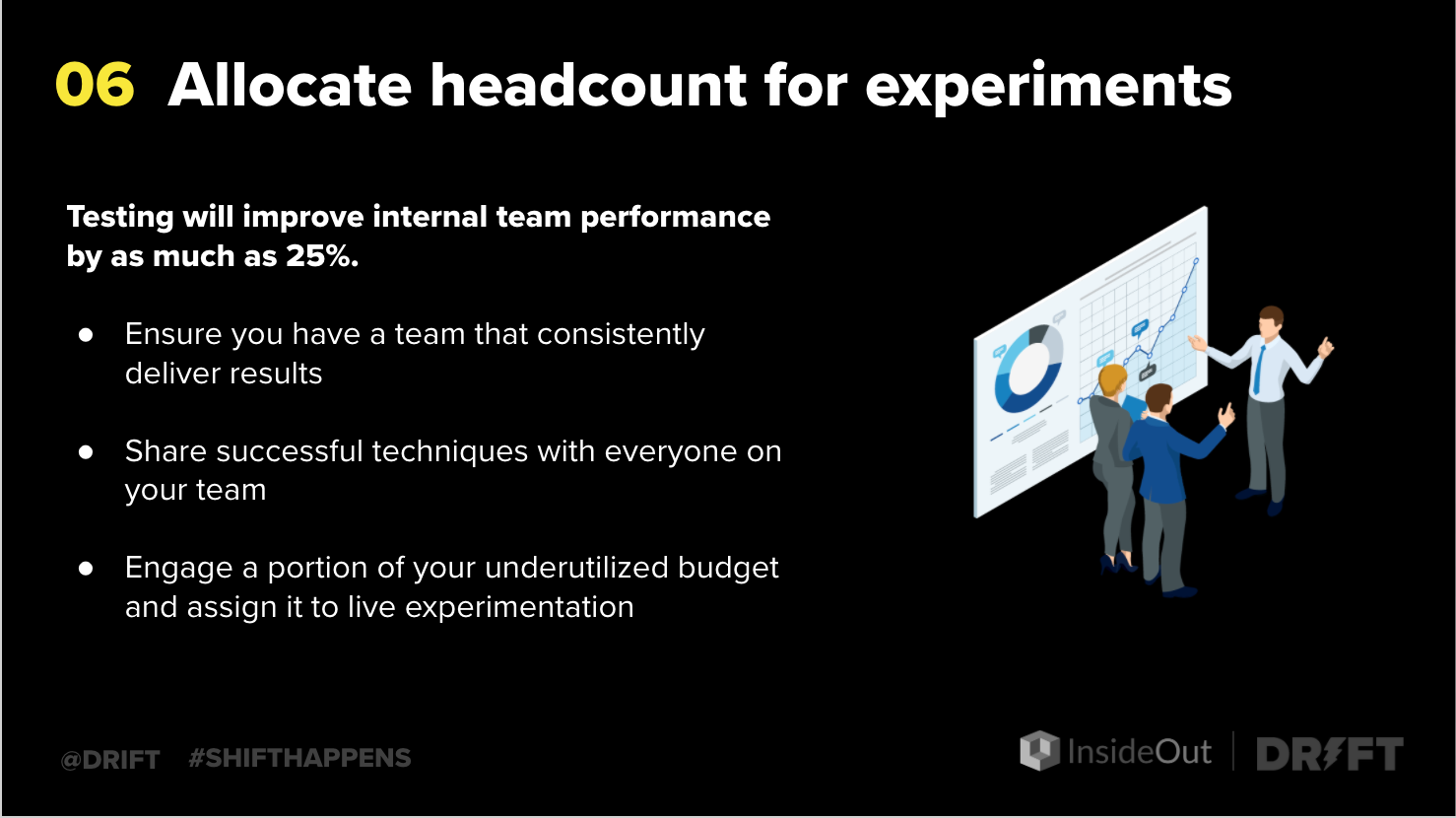
Which brings me to the most important step of all: building experimentation to improve sales performance.
Everyone has an opinion, and usually, the loudest one wins.
An engineer would never ship code to your customers without testing it first. But salespeople send emails all the time without testing anything, just because it feels right (or because they saw a LinkedIn thought leader sharing the so-called latest and greatest approach to prospecting).
That’s no way to run a business.
The only way to know what really works is to test, measure, iterate, and repeat. You need to run your sales process the same way your product and marketing teams run their campaigns: A/B testing.
The more you test, the more likely you’ll hit upon the winning plays and messaging, so when your sales rep says, “Nah, I’ve got my own plays,” you can say, “Well this play generates 25% more sales, are you sure?”
To transform, you have to find what works – and then scale it.
7. Enforce winning strategies
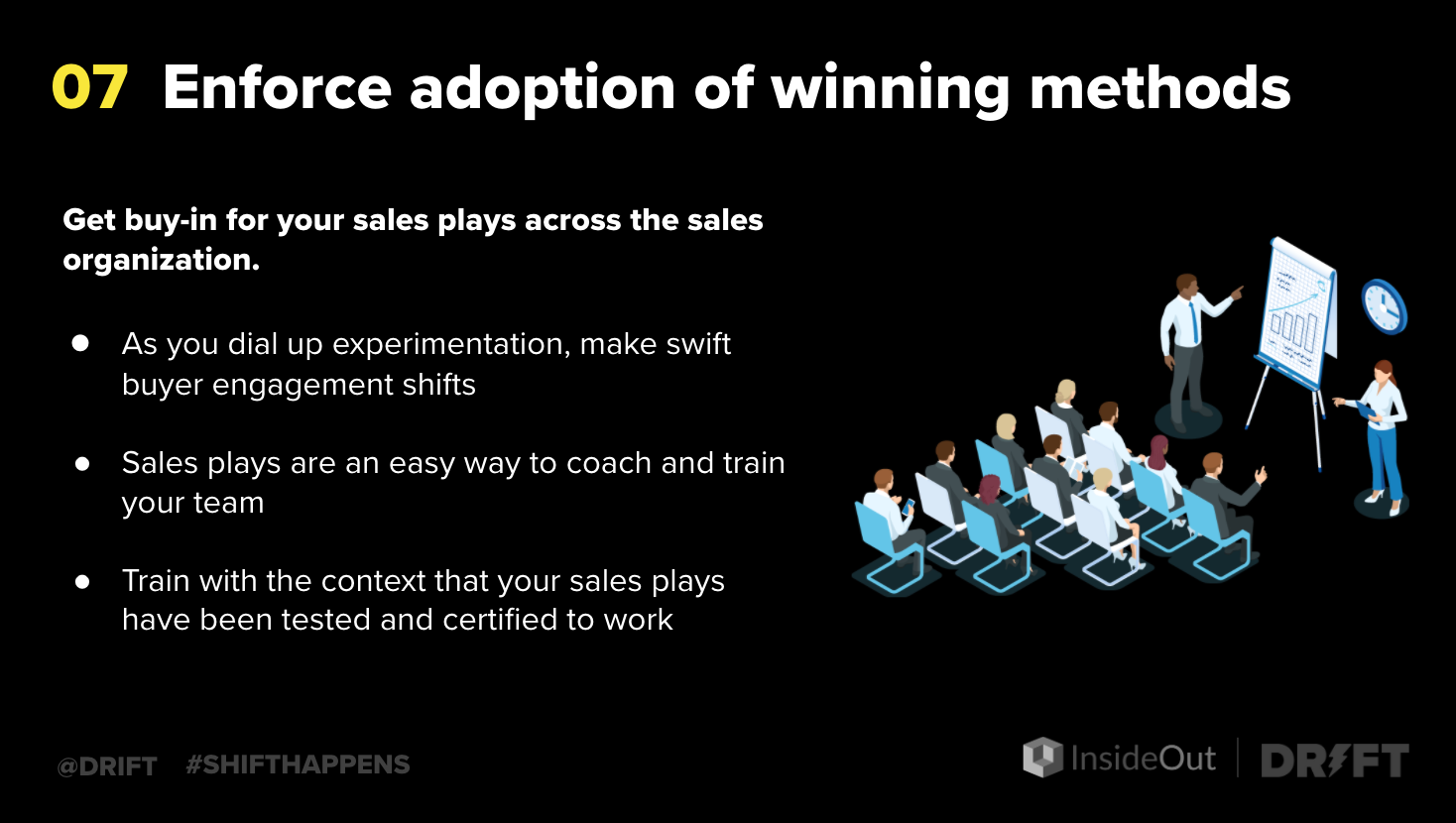
What’s your top performer doing right now?
If you don’t know, you’ll never be able to scale it to the rest of your organization.
Your sales team has to learn from one another. Everyone should be using top-performing methods, fine-tuning them to work based on industry, geography, and persona.
Seeing what your top performers do and scaling their messaging and behaviors gives any experimentation credibility. If you know one rep is knocking it out of the park, it’s much more motivating to say it’s from them than from you. Now, you can go to three or four teammates and say, “This talk track works for so-and-so. Test this and we’ll measure the call conversion rates between them, and then whichever one works best will become standard for everyone.”
This helps you take what your best rep is doing and scale it across your team, resulting in a larger percentage of quota participation.
Then in a couple of months, you can say, “Hey, here’s a new top track, guess what? We know it works. It’s proven. And we collaborated with some of the top performers.”
Win-win-win.
8. Certify plays through analytics
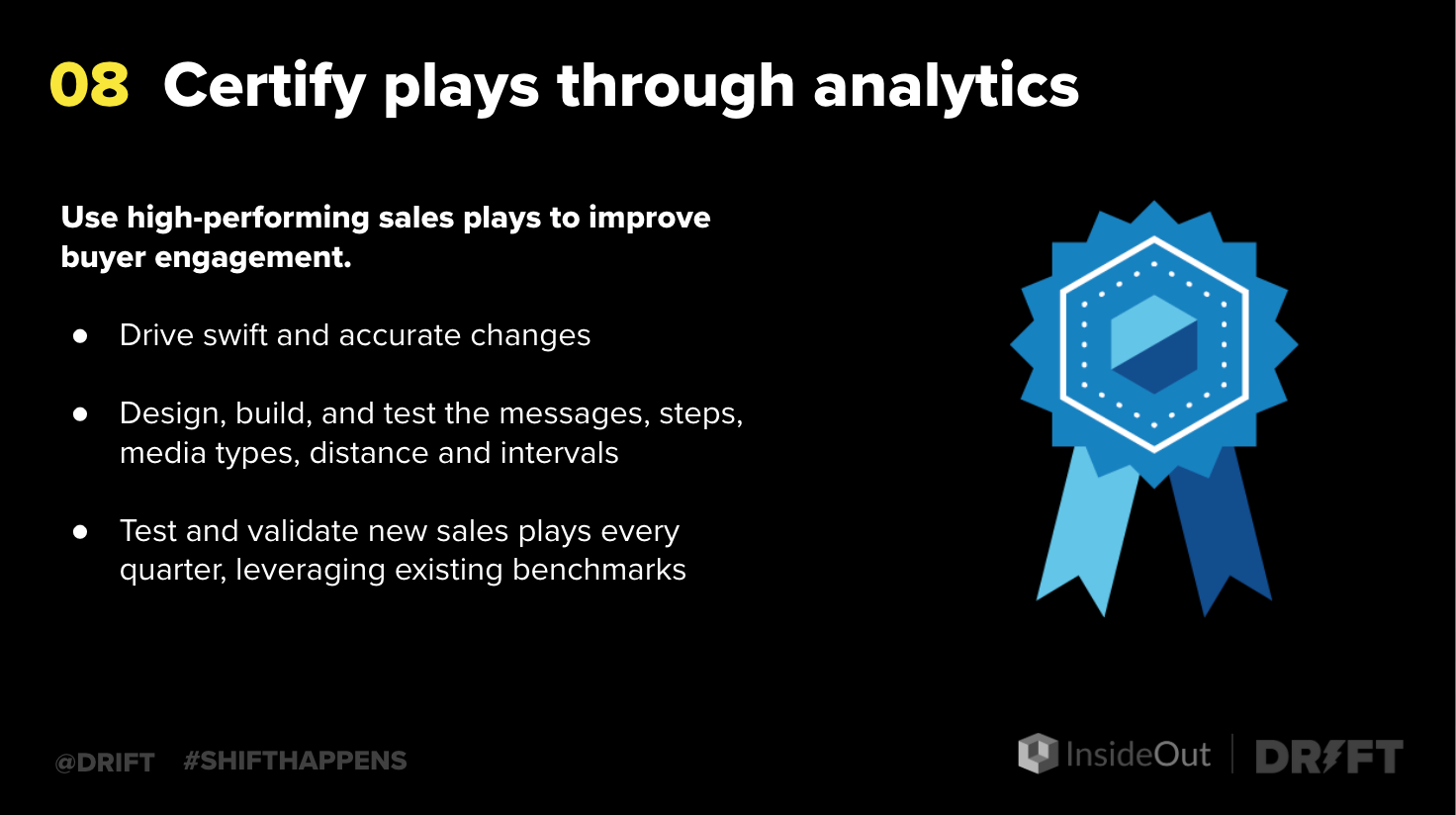
Of course, you have to know how it works.
If you’re going to test, you need to validate and certify the winners.
The first is quantitative statistics – conversion rate, opportunity to close rate, average order size.
The second is qualitative – ask your team how customers react, where things stumble, what’s a slam dunk.
Now you can improve sales performance for every play by customizing it based on buyer persona and industry. That way every change you make you can measure the impact and guarantee to your team that they can run this play and hit their numbers.
9. Understand the voice of your customer
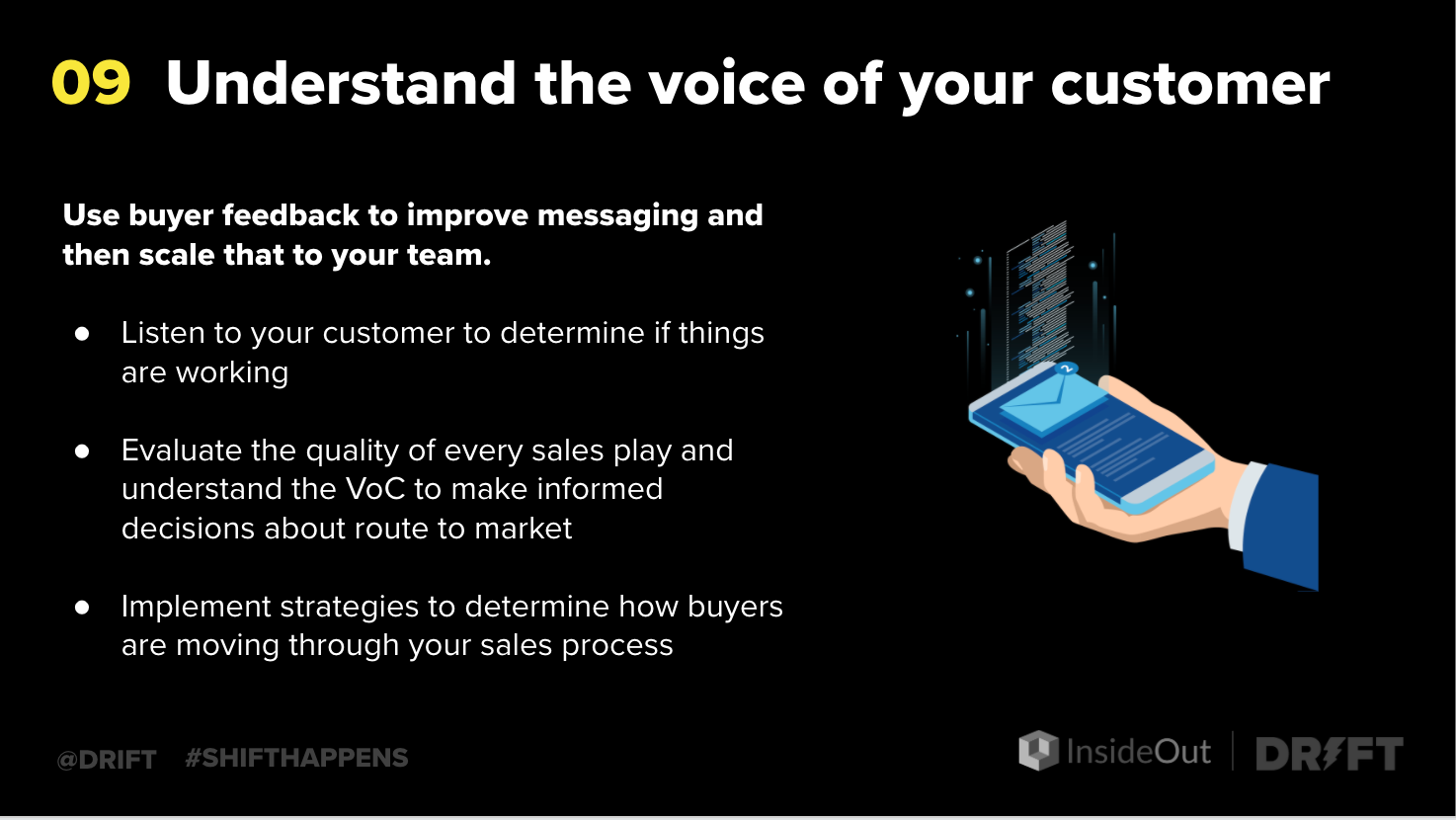
So many people build plays around what they think the buyer wants to hear. And so many of these people get it wrong.
The beauty of experimentation is that it forces you to build a process around getting it right.
You have to internalize the voice of the customer.
In every discovery call, you’re learning something about the customer. Record those calls, listen back to them, and mark customer sentiment or score the calls based on your pitch. Instead of making it all about you, make it all about them.
The more in tune you are with your customers, the better off you’ll be.
Improve Sales Performance with Experimentation
Marketers, engineers, product managers…they all test. Your sales team should, too.
Engaging with your prospects is what’s going to set you apart.
To do that requires you to set out systematic processes that enable personalization at scale. Test out your plays, see what’s resonating, adjust, repeat.
That’s how you’ll take your team to the next level and improve sales performance.
Looking for a way to build the pipeline you need to hit your number – without adding headcount? Get a demo of Drift’s ai chatbots today.
And don’t miss our upcoming webinar to hear how a Drift customer transformed their business with Drift’s Conversational AI. Sign up here to save your spot.





